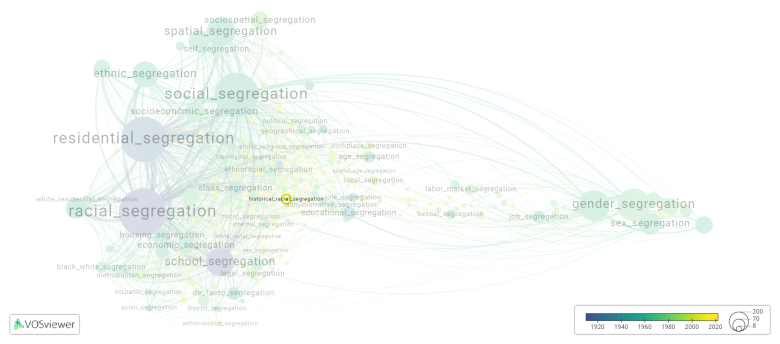Historical racial segregation: Difference between revisions
(Creating page) |
(Creating page) |
||
| (One intermediate revision by the same user not shown) | |||
| Line 16: | Line 16: | ||
Ultimately, historical racial segregation left a lasting impact on society, contributing to disparities in education, wealth, and opportunities that persist to this day. While significant progress has been made, racial inequalities and the effects of segregation can still be seen in various social, economic, and political spheres. | Ultimately, historical racial segregation left a lasting impact on society, contributing to disparities in education, wealth, and opportunities that persist to this day. While significant progress has been made, racial inequalities and the effects of segregation can still be seen in various social, economic, and political spheres. | ||
===== Synonyms ===== | ===== Synonyms ===== | ||
The following terms are synonymous with: | The following terms are synonymous with historical racial segregation: | ||
historic racial segregation. | historic racial segregation. | ||
| Line 28: | Line 28: | ||
[[File:historical_racial_segregation.png|780x780px]] | [[File:historical_racial_segregation.png|780x780px]] | ||
This visualization is based on the study [[Segregation_Wiki:About| The Multidisciplinary Landscape of Segregation Research]]. | |||
For the complete network of | For the complete network of interrelated segregation forms, please refer to: | ||
* | * [https://tinyurl.com/2235lkhw First year of publication] | ||
* | * [https://tinyurl.com/2d8wg5n3 Louvain clusters] | ||
* | * [https://tinyurl.com/223udk5r Betweenness centrality] | ||
* | * [https://tinyurl.com/244d8unz Disciplines in which segregation forms first emerged (Scopus database).] | ||
==References== | ==References== | ||
==Notes== | ==Notes== | ||
Latest revision as of 07:17, 16 October 2024
Date and country of first publication[1][edit | edit source]
2017
United States
Definition[edit | edit source]
Historical racial segregation refers to the systematic separation and discrimination of individuals based on their race or ethnicity. It was prevalent in many parts of the world, but particularly notable in the United States during the era of Jim Crow laws.
In the United States, racial segregation was legally enforced through a series of laws and policies that aimed to separate white and black populations in various aspects of life, including education, housing, employment, transportation, and public facilities. These laws were established primarily in southern states after the Reconstruction era following the American Civil War and lasted from the late 19th century until the mid-20th century.
Under racial segregation, African Americans faced numerous forms of discrimination and unequal treatment. They were assigned separate and inferior facilities, such as schools, bathrooms, restaurants, and public transportation. They were also denied access to certain job opportunities, political participation, and the right to vote through practices like literacy tests and poll taxes.
The Supreme Court's landmark decision in the case of Plessy v. Ferguson in 1896 upheld the principle of "separate but equal," which allowed for racial segregation as long as the facilities provided for whites and blacks were theoretically equal. However, this rarely translated into equal treatment in practice, as facilities for black Americans were typically inferior.
Racial segregation became a deeply ingrained aspect of American society, perpetuating a cycle of inequality and discrimination. It was not until the mid-20th century with the emergence of the Civil Rights Movement that significant strides were made to dismantle segregation. Events like the Montgomery Bus Boycott, the sit-ins, and the Freedom Rides played a pivotal role in challenging and ultimately overturning segregation laws.
Ultimately, historical racial segregation left a lasting impact on society, contributing to disparities in education, wealth, and opportunities that persist to this day. While significant progress has been made, racial inequalities and the effects of segregation can still be seen in various social, economic, and political spheres.
Synonyms[edit | edit source]
The following terms are synonymous with historical racial segregation:
historic racial segregation.
References and literature addressing this segregation form under these synonymous terms can be found below.
See also[edit | edit source]
Related segregation forms[edit | edit source]
Historical racial segregation is frequently discussed in the literature with the following segregation forms:
This visualization is based on the study The Multidisciplinary Landscape of Segregation Research.
For the complete network of interrelated segregation forms, please refer to:
References[edit | edit source]
Notes[edit | edit source]
- ↑ Date and country of first publication as informed by the Scopus database (December 2023).
At its current state, this definition has been generated by a Large Language Model (LLM) so far without review by an independent researcher or a member of the curating team of segregation experts that keep the Segregation Wiki online. While we strive for accuracy, we cannot guarantee its reliability, completeness and timeliness. Please use this content with caution and verify information as needed. Also, feel free to improve on the definition as you see fit, including the use of references and other informational resources. We value your input in enhancing the quality and accuracy of the definitions of segregation forms collectively offered in the Segregation Wiki ©.
Historical racial segregation appears in the following literature[edit | edit source]
Andrews R., Casey M., Hardy B.L., Logan T.D. (2017). Location matters: Historical racial segregation and intergenerational mobility. Economics Letters, 158(), 67-72. Elsevier B.V..https://doi.org/10.1016/j.econlet.2017.06.018
Triguero-Mas M., Fontán-Vela M., Dommerholt T. (2021). CAN COMMUNITY MOBILIZATION BE INCLUSIVE OF THE BLACK COMMUNITY IN ITS FIGHT AGAINST GREEN GENTRIFICATION?. The Green City and Social Injustice: 21 Tales from North America and Europe, 283-294. Taylor and Francis.https://doi.org/10.4324/9781003183273-26

